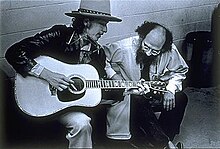Dylan delayed the album's release and re-recorded half the songs at Sound 80 Studios in Minneapolis with production assistance from his brother, David Zimmerman.
Released in early 1975, Blood on the Tracks received mixed reviews. In the NME, Nick Kent described the "accompaniments" as "often so trashy they sound like mere practice takes". In Rolling Stone, Jon Landau wrote that "the record has been made with typical shoddiness." Over the years critics came to see it as one of Dylan's greatest achievements. For the Salon website, journalist Bill Wyman wrote: "Blood on the Tracks is his only flawless album and his best produced; the songs, each of them, are constructed in disciplined fashion. It is his kindest album and most dismayed, and seems in hindsight to have achieved a sublime balance between the logorrhea-plagued excesses of his mid-1960s output and the self-consciously simple compositions of his post-accident years".
In the middle of that year, Dylan championed boxer Rubin "Hurricane" Carter, imprisoned for a triple murder in Paterson, New Jersey, with his ballad "Hurricane" making the case for Carter's innocence. Despite its length—over eight minutes—the song was released as a single, peaking at 33 on the U.S. Billboard chart, and performed at every 1975 date of Dylan's next tour, the Rolling Thunder Revue. The tour featured about one hundred performers and supporters from the Greenwich Village folk scene, including T-Bone Burnett, Ramblin' Jack Elliott, Joni Mitchell, David Mansfield, Roger McGuinn, Mick Ronson, Joan Baez and Scarlet Rivera, whom Dylan discovered walking down the street, her violin case on her back.

Niciun comentariu:
Trimiteți un comentariu